#gevherhan sultan daughter of selim ii
Text
reallifesultanas Thank you very much for your answer! Yes I meant Dumas not Alderson sorry for that! Is there a reason for the illogical amount of salaries? I mean the earlier salary lists of registers clearly help us to indentify the sultanas. The 1555-1556 registers are 100% logical; the 1603-1604 registers are still logical: Safiye, Handan, aunts of Ahmed, great-aunt of Ahmed, great-great aunt's daughter (Ayse Hümasah), cousin of Mehmed III, far relatives. But then there is this one.. highest salary for the full sisters of the sultan is logical, but then what does the daughters of Murad III doing there? Fahri/Kamer and Hümaşah/Rukiye* are surely Murads and so Ümmügülsüm could be also Murad's... For the lesser salaries Beyhan, Safiye, Hatice I could imagine they were Mehmed III's, maybe Beyhan's Mustafa was Mirahur Mustafa? But these stipends are just not logical... (*Murad III's daughte Rukiye was said to be married to Nakkas Hasan not Huma). And for Ümmügülsüm there is that one report from 1688 (Katherine Trumbull) when it is said she developed a relationship with Sultana Ümmühan, the aunt of the deposed Sultan Mehmed IV, through visits to the harem. This Ümmühan could be Halil Pasha's wife and so Murad III's/Mehmed III's daugher, or is it more likely not an aunt but sister/cousin? Or she truly can be Ahmed I's daughter? There is this 85 numaralı Mühimme defteri that provide some informations suggesting suggesting Ümmügülsüm was sister of Murad IV. Sadly I dont have the book so I cannot check how true is this claim...
I hope you don't mind if we continue here on ottomanladies.
I know the harem register doesn’t seem to make sense from the point of view of hierarchy but we must remember that the hierarchy could be broken on the basis of favouritism. Maybe those aunts were more favoured than the others.

In this table we can see Gevherhan Sultan, a great-aunt of Ahmed I’s, the reigning sultan. Dumas mistakenly identifies her as a daughter of Murad III’s and a concubine of non-haseki rank, but the reality is she’s first because she’s the most senior princess alive. If you look closely at the second category — “Frais de bouche” — she receives the same amount as Ayse and Fatma, Safiye’s daughters. Gevherhan was quite favoured by Ahmed I because she had trained Handan in her household. Also, her late husband Cerrah Mehmed Pasha had performed Ahmed I’s circumcision. Borekçi says that she was the only recipient — apart from Handan and Safiye — of sable fur:
“A register preserved in the Topkapı Palace Archives gives further details of the gifts Gevherhan Sultan received from her great grand-cousin. At the beginning of this register, there are records of the furs and robes of honor sent by the new sultan to his larger family right after his enthronement on December 27, 1603. Here, Gevherhan Sultan is listed as a recipient of a sable robe (semmûr kaplu nimtâne) and recorded as the third female member of the dynasty after the retiring queen mother, Safiye Sultan, and the new queen mother, Handan Sultan, and before all other living sisters and daughters of Murad III and Mehmed III -- a clear indication of her privileged position. Later, on February 6, 1604, she again appears in the register, this time as the only female family member apart from Handan Sultan to receive a fur-trimmed silk robe.”
(I believe the 6 şehzâdegân are unmarried princesses that Ahmed still had to matchmake but this is another story)
I know it’s Rukiye that Öztuna says has married Nakkaş Hasan Pasha but he could be wrong tbh, it wouldn’t be the first time. Also, neither Sakaoğlu or Uluçay confirm this; they give no information about Rukiye except for the identity of her mother. Unfortunately Öztuna never gives his sources so we don’t know where he found that Rukiye was married to Nakkaş Hasan Pasha. I would trust the harem register and contemporary sources (the ragusian diplomat, in this case) more tbh… both say that Nakkaş Hasan Pasha was married to a princess called Hümaşah…
About Beyhan… the problem is the wife of Mirahur Mustafa Pasha went on to marry Cigalazade Sinan Pasha’s son Mahmud Bey in 1612, and died before 1620, the date of Mahmud Bey’s second wedding, which means she shouldn’t have been alive in 1638-39. The Ragusian letter date 1648, though, lists a Beyhan Sultan widow of “Nideli Mustafa Pasha”— unfortunately, I can’t say who this man is or what “nideli” means.
I do agree with you, though. I think that Beyhan, Safiye, and Hatice are daughters of Mehmed III. We know that seven princesses were married in the summer of 1613, after all. A letter dated July 1613 by a Ragusian diplomat, furthermore, says that “at the present there are fifteen sultanas”.
About Katherine Trumbull, I guess you mean this:
“While in Istanbul, Katherine had developed a relationship with Sultana Ümmühan, Mehmed IV’s aunt and sister to Ibrahim II. On 14 July 1688, Katherine met with Ümmühan for the first time, and the two women continued to meet in the imperial harem throughout Trumbull’s residence in Istanbul. During these visits, Katherine must have been accompanied by someone with knowledge of spoken Turkish, or else it is unclear how she would have been able to communicate with the women she met in the harem. At any rate, when she returned to the embassy, she brought to Trumbull news of things taking place in the Ottoman court.” — Ghobrial, John-Paul A, 'Overcoming Distance in Everyday Communication', The Whispers of Cities: Information Flows in Istanbul, London, and Paris in the Age of William Trumbull (Oxford, 2013; online edn, Oxford Academic, 23 Jan. 2014)
Unfortunately, William Trumbull’s diaries were not published, they’re in the British Library. I always like to cross-check my sources and the fact that I can’t read the original kind of annoys me. Ümmühan is quite an unusual name for an Ottoman princess: Ümmi means mother and Han sovereign, it kind of sounds like “valide sultan”, which is why I thought it was a title for a moment but I couldn’t find anything to confirm this. It is kind of interesting, though, that Öztuna says that Ibrahim’s eldest daughter was called Ümmügülsüm, who could have been named after another Ümmügülsüm (the one that in 1622 was unmarried? Who knows)
The Mühimme defteri is not a book but a collection of copies of all the imperial decrees or decisions taken in the imperial council. They’re numbered and the number 85 refers to the years 1630-31. You can find the PDF for free on the website of the Turkish National Archives but, well, it’s in Ottoman Turkish.

(This is one of them)
So I can’t really read it even though I have it.
#ask: ottoman history#reallifesultanas#gevherhan sultan daughter of selim ii#rukiye sultan daughter of murad iii#humasah sultan daughter of murad iii#unnamed daughters of mehmed iii#i'm sorry if the layout looks weird but it's been so long since i used tumblr and i'm a little rusty
11 notes
·
View notes
Text
Lets talk about Ümmügülsüm Sultan
There is a chance, that Kösem and Ahmed had another daughter together: Ümmügülsüm.
I am so glad, that with Anonymous sender and Ottomanladies, the truth came to light. Ottomanladies answered very long and very detailed about Ümmügülsüm, she shared her thoughts about the topic, now, here, you can find a conclusion from me:
What we know:
A privy purse register from 1622 gives the names of five unmarried princesses, who may be daughters of Ahmed, Osman II, and even Mehmed III: Umm-i Külsum(=Ümmügülsüm), Hanzade, Halime, Fatma, and Akile. Hanzade and Fatma were Kösem's daughters; Akile is possibly mistaken for Atike or Abide; Halime might be Mehmed III's daughter, named after her mother, Halime. But Ümmügülsüm was less clear.
The relazione of Angelo Alessandri from 1637 says that Murad IV had four FULL-sisters. We know three of them: Ayse, Fatma, and Hanzade. But who could be the fourth? Gevherhan was already dead, Atike was well-knownly not a full-sister and also not Abide. Maybe Ümmügülsüm?
There are some decisions and letters of Murad IV, where he mentions Ümmügülsüm as a sister of his. He uses the same wording that he used for Ayse, who undoubtedly was his full-sister, suggesting Ümmügülsüm was also a full-sister of his.
The 1638/39 harem registers mention one Ümmügülsüm Sultan who received the highest payments besides the three already known daughters of Kösem (Ayse, Fatma, Hanzade) and two daughters of Murad III. This means she could be either the daughter of Murad III or Ahmed I. But since Ahmed I's other daughter, Atike - who was not Kösem's - got a lesser stipend, if Ümmügülsüm is Ahmed I's daughter, she had to be Kösem's daughter too and so she is the fourth full-sister of Sultan Murad IV.
In 1648 the Raguzan envoy also mentions her (possibly her as they use the name Iumi), as the wife of Ahmed Pasha, governor of Herzegovina. They probably married ~1642 until the pasha's death in 1648. This was her second marriage, her first husband was one Halil Pasha, with whom she married before 1638.
In book ''Whisper of the cities'' one Ümmühan Sultan is mentioned as she met with the English ambassador's wife. Based on her, Ümmühan was said to be the aunt of deposed Mehmed IV and sister of Ibrahim I. This happened in 1690, so she still was alive then.
There are still questions:
Why no historian ever discovered this information as none of the evidence is new?
Why Ümmi is not mentioned among Ahmed I's children?
Where is she buried? *
When was she born? *
Why Ibrahim did not force her to serve Telli Hümasah (his wife) when he did it to all of the other daughters of Kösem?
To be honest the burial place of Ahmed I is quite a mess. For example there are two sarcofagies for 'Zeynep' daughters of Ahmed I. One of the sarcofagies stands for an adult woman. There was no daughter of Ahmed, called Zeynep who reached adulthood. So maybe the name is mistaken and that Ümmügülsüm. Maybe she was buried somewhere else as she lived a quite long life, survivin everyone around her and her grave is not idetified yet.
Considering the known children of Kösem and their birth date, the most possible for Ümmügülsüm is that she was born during the late reign of Ahmed I. In 1605 Kösem gave birth to Mehmed; in 1606 or 1607 to Ayse; then in 1607 or 1608 to Fatma; in 1609 to Hanzade. While I see that there is a gap here for one more child (if Kösem got pregnant extremely rapidly), she cannot be older than Fatma, as she was also not married off in 1622 yet, and also since we know quite precisely the sequence of these daughters, I do not think another one was born here but no one knows about her. It would be strange. Then in 1612, she gave birth to Murad, but between him and Hanzade there was time for another child - let it be Selim who was born in 1611 or Ümmügülsüm. Then Kasim followed Murad quite quickly, he was born in 1614, and then Ibrahim came in 1615, so there was no time for anyone else between Murad and Ibrahim. After 1615 there is another chance for the birth of Ümmügülsüm. So she either was born after Hanzade (~1611), or after Ibrahim (~1616). Either way - considering she was not just still alive in 1690, but was surely not suffering, dying since she was involved in the diplomacy meeting - she possibly died in the 1690s, she very probably reached 80 maybe even more in the end.
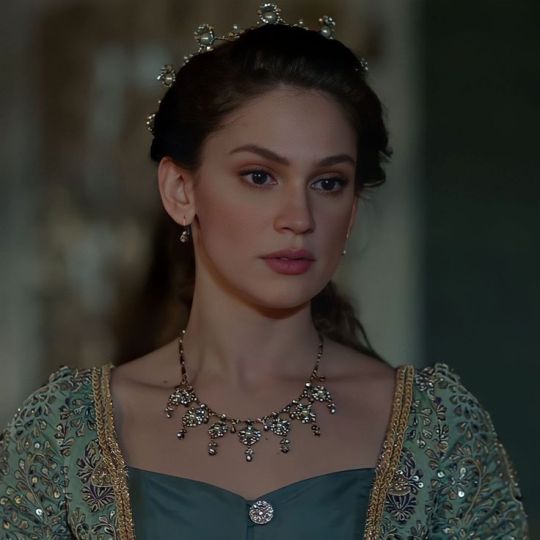
#ottoman history#ottoman empire#valide kösem sultan#mahpeyker kösem sultan#kösem#ahmed i#ümmügülsüm#ümmügülsüm sultan#ümmi#ummuhan#ummugulsum#ümmihan#ummukulsum#ümmükülsüm
16 notes
·
View notes
Text
Power and status of ottoman princess
Title and honorifics
Before the rule of sultan Bayazid II every high ranking woman were called Hatuns,including mother,sisters,aunts and daughters, however thier social standing was naturally higher than non imperial women. The way to adrress them was Hatun that was used after their given name,for example, Gevherhan hatun,daughter of Mehmed the coqueror or effendi that would have similar meaning as mistress.
After accession of Bayazid II his daughters and granddaughters were given title of sultan,however non of his living sisters or aunts got the honor. Later on proper way to adress them woulf become “Sultanim”, which would mean “my sultan”,or again “effendim” by other members of imperial family. I would like to underline that contrary to what wikipedia states, there is no records that I know,where princesses where called with “Devletlu İsmetlu” like Valide sultan and Haseki sultan were.
The term “sultana” that was made more feminine by Europeans never existed in ottoman language.
Family, Marrige and Issues
I want to start discussing their family with brothers,it’s widely known fact that before suleyman there was “once concubine,one son” tradition therefore if shehzade/Sultan had full-sisters they were all older,that is one way to deduce if princess of unspecified mother was full sister of half sister of reigning sultan. Naturally Shezades had closer relationship to their full sisters as they were leaving with him and their mother,when he was appointed as governor of princely province. Their latter life would be spent in their brother’s harem before marriage.
being half sister of sultan did not automatically mean that their relationship would have been stained,however mostly,princess would favour full-brother over half,but were treated by same respect regardless who ascended the throne. It was different case when imperial princess had no full brother at all,for example Sah Huban, she had very close relationship with Suleyman,even closer than his deeply respected full sisters.
Their marriages,much like any other princesses of any country, was political,arranged by their parents to strengthen standing of their father or brother,for example daughters of Selim I were firstly married to powerful politicians,so their father would have supporters in his rebellion,while their second marriages were arranged to help Suleyman in his early reign. Their husbands were usually much older than them, therefore marital life was likely not consensual and in no way their choice. For example,Rustem paha,husband of Mihrimah,was same age as Hurrem,her daughter’s fate was even worse as she had to marry peer of her own grandfather,however given the fact that they had 8 children,marriage can be considered successful. After the Marriage princesses were getting their own little “Harrem”,where they had great rooms for themselves and their servants,where even their Husbands needed permission to enter and even refuse to have sexual intercourse with them,sometimes their marriage could end unconsumated and after some time princess could use another of their privilege-divorce. Reason of divorce could have been different: Personal attitude,mistreatment,political move or adultery. It was made clear,especially by Suleyman,that imperial princesses were full-fledged members of imperial family so they ranked higher than their husbands,therefore having relationship with other women was their humiliation,which would lead to divorce, after which they would retire in old palace and could refuse to remarry again.
Only their first degree descendants would be given imperial titles.
Daughters- Hanimsultan(with Ayse Humashah as exception)
Sons-Sultanzades. They ranked even below non-sultan imperial consorts and some of the highest ranking harem servants.
Hierarchy and Power
They actually had equal standing in ottoman hierarchy. As female members of dynasty they had the same status and privileges,were reffered as sultans and often received relative stipend.( Which was on average 200 akche a day, for comparison, Valide sultan had around 2000-3000 depended on time period, Haseki sultan 1000-1100(Hurrem as only exception,who got stipend of Valide sultan ) Gulfem,who was almost regarded as member of family herself was recieving 150, Nurbanu’s trusted friend and one of the highest ranking non-sultan woman ever Canfeda received 200, Mahidevran only received 40 and avarage stipend of cariye was 2-4) Besides, sisters of sultans were technically daughters of sultan, though the deceased one, still they were treated with great respect much like their late father. However, birth order was important thing in ottoman society so younger sister respected older and bowed to them as well as nieces bowing to aunts regardles of their martial or fianacal status. Therefore saughters of sultan,as nieces, were calling sisters of sultan,as aunts, “effendi" out of respect.
In conclusion, even if they had same social standing, sisters of sultan were still bit ahead daughters of sultan formally.
However, Granddaughters, Nieces and cousins of sultan,despite the same rank, were less prestigious.
Despite their relative social status and order of birth their actual power was dependent on several factors:
1. Their relationship with Padishah,Valide sultan or Haseki sultan. They had higher rank and much more evident political power, they still needed their permissions about major decisions,even if it were their right, so being on good terms with them was a good move. Half-sisters naturally were not as favoured as full-sisters by Valide sultan,but with padisah had more options, they could have been supportive, religious, charitable and obedient another way was sending beautiful, well-educated concubines,who could have become Haseki(after 1533), that is when their good relationship begun,most of Sultanate of women memebers were raised at their court and remained in favour after they became Valide Sultans, in that case even some of the Padisah’s expressed gratitude and gratefulness for raising their mother, (such occasion was Ahmed I’s attitude towards her aunt which I will discuss below.), they could also donate money to wars, harem managements and charitable projects, either all their own or assist Haseki sultan.
2. The second way to gain power was wealth. Money opens many doors and it was like that in the past. They could establish some business or even receive bribes.
3. They could also gain power with marriages, it was not only beneficial for their brothers,but for them as well. If their husband had a high rank, they could keep an eye on the political situation and act accordingly, they would use that influence to assist their brothers, who,In turn, would be extremely grateful for their support.
Comparison between Ottoman and European princess
Status- Status of European princesses depended on their marriage. Being princes was not guaranteed power,but only a formal status. For example, Margaret Tudor was below prince Henry in rank but when she married by proxy to Scottish king, she outranked him and demonstrated that by walking in front of him. On the other hand, another sister Mary married to Charles Brandon and was Duchess of Suffolk ever since,while Status of Imperial princess remained the same.
Opportunity- European princesses could have become Queen consort and Queen mother and veiled immense power, while imperial princesses could never become Haseki or Valide.
Marriage- Ottoman princesses were usually older when married and outranked their husbands,while European princesses were always below their husbands. Sultan could also refuse remarryin,while European princesses had no such right
Freedom-European princesses were less limited by social customs.
Consummation-Ottoman princesses had the right to refuse Consummation without a deadline, while European princesses had to Consummate marriage even if they were twelve, unless of course parents arranged it other way.
Divorce - it was right of ottoman princesses to divorce their husbands,while for European princesses it was a rare privilege.
Despite so many differences, one thing was same- they had a loveless purely political match .
Powerful ottoman princesses
Here I Rank ottoman princesses,who had considerable power and influence, sorted by date of birth.
P.S gifs are from MC and MC:K,but some characters might represent different historical figures.

Fatma sultan
Fatma may have been the second child of Ayşe Hafsa and Selim I . She was born in Trabzon around 1492 and spent her childhood there. When her younger brother Süleyman received his own princely province in 1509, she probably accomponied him to Caffa with their mother.
She was married in 1516 for the first time,but it soon ended in divorce and Fatma returned to Manisa. She gained considerable influence as she was most likely the sister,who was recorded to be in Manisa, helping mother manage harem and protect Suleyman from their father. If legends are true and Selim was indeed trying to kill Suleyman,that she had hands in saving him. Most likely, Fatma and her mother were instructing young sukeyman,how not to deserve the wrath of father and covering his mistakes. After Suleyman ascended the throne, she was married again to Kara Ahmed pasha in 1522. Marriage lasted long,but did not produce any child, so either fatma was infertile (Kara Ahmed pasha had two daughters that are disputed to be fatmas,but they were likely from previous marriage) or the match was not happy and Fatma refused sexual intercourse, however considering her reaction to his death, it was most likely the former.
According to what we have Fatma seems to be quite free spirited as depicted in the series. She was wealthy, cunning and might have been fond of parties. She had hands in financing some of her brother’s campaigns and even won the favour of janissrries. However, in 1555 Kara Ahmed pasha was executed by the efforts of Mihrimah and Hurrem and Fatma was married to eunuch and banished from the capital for hed intrigues against them She died either in 1557 or 1573.

Sah huban sultan
Daughter of Selim I and unknown concubine, born in 1500. As she has no full brothers, she was very close to Suleyman and their father, with whom she spent most of her childhood. Considering Suleyman’s great respect for her, Sah was likely a supporter of him and helped to deal with Selim I.
She was married in 1523 to well-educated and intelligent Lutfi pasha with whom she shared religious thoughts and beliefs. Marriage, however did not seem to be successful the couple only had one daughter and Sah refused to have a sexual relationship ever since. She was very pious, intelligent,outspoken and fierce in nature. In the only description of her daughter Esmahan Burnaz, it is said that she was arrogant and demanding and it was Shah’s domineering attitude in the family that was blamed for it, as by this “she had ruined the role of woman” in the child’s mind. However,that was recorded by the European ambassador only, who had never met any of them and probably heard some rumors or made it up after an ugly end of their marriage.
In 1541, Lutfi pasha punished a prostitute for adultery by mutilating her genitals.Şah could not tolerate the humiliation and mutilation of a woman without a word, which is why she got into an argument with her husband, who hit her . Şah had Lutfi pasha beaten up and immediately asked his brother to allow the divorce. Süleyman then exiled him. Şah remained with her brother in Istanbul for the rest of her life and supported the wife of Süleyman, Hürrem, in carrying out her construction projects. She lived a modest life in the Old Palace and devoted all her time to charity and religion. Shah had excellent relationship with Hurrem and Mihrimah and in my opinion, close bond between aunt and niece helped young sultan to shape her mind and characteristics.
She died in 1572 and was buried in her father’s complex.

Mihrimah Sultan(1522-1576)
Her life is very much known. She was the most powerful imperial princess in the empire, so I will just list some of her achievements:
1. Her stipend was 600 akches a day during the reign of three different Sultans. it was three times as much as regular pirncess
2. She had correspondence with Catherine de Medici and other foreigner diplomats, who would often send her gifts to help them in some political affairs.
3. She financed some of Suleyman’s campaigns all her own
4. She built a whole fleet of 400 ships.
5. She had three palaces and two mosques
6. She served as sole de facto Valide from 1558 to 1566 and shared it with Nurbanu from 1566 to 1574.
7. After the death of Bayazid Mihrimah banned everyone from laughing and sent back clothes to Suleyman and Selim who were secretly planning a grandiose wedding, that was cancelled by Mihrimah and instead a very plain ceremony was held.
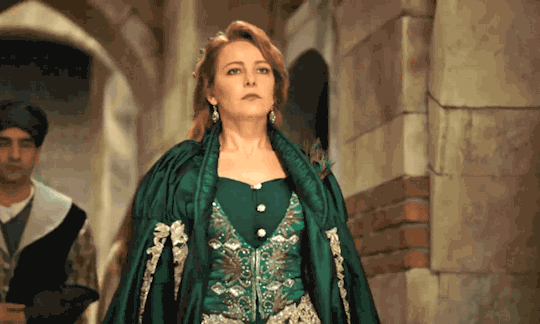
Humasah 1543-c.1582 or later
She was a posthanous daughter of Shehzade Mehmed and despite being only a daughter of prince, she was given the same privileges,but greater power, as any other sultans. She was one of two favourite grandchildren of Hurrem and Suleyman. She married three times,but the source of her power was a good relationship with Sultans. She was the one who raised Safiye and gifted her to Murad, so her power reached it’s peak during his reign.
She financed many construction projects,but was buried in a mosque that was built by Hurrem and Suleyman for her father.

Ayse Humasah 1543-1594.
Daughter of Mihrimah sultan and Rustem pasha, she was practically the same as her cousin with whom she shared many things started from date of birth and ended with their name. Ayse Humasah was the only woman born to an ottoman princess,who was herself addressed as sultan and her children were considered members of the dynasty. She was married two times and her influence was extremely great during the reign of three Sultans. Her power reached it’s peak, when her husband was appointed a grand Vizier and she had hands in very major political decision.

Gevherhan Sultan. 1544-after 1526.
Eldest child of Nurbanu and Selim. She was married to Piyale Pasha, an admiral who died in 1578 and she was remarried in 1579. She was one who raised Handan and gifted it to the prince, for which not only Handan was grateful, but her son Ahmed as well, who after his accession gifted very expensive furs to Handan, Gevherhan and Safiye. The second gifts were given to Handan and Gevherhan only,which indicates that unlike Safiye,she never fell from his favour. Peak of her power was from 1598 during her husband’s grand vazirate. She did a lot of charity in her life.
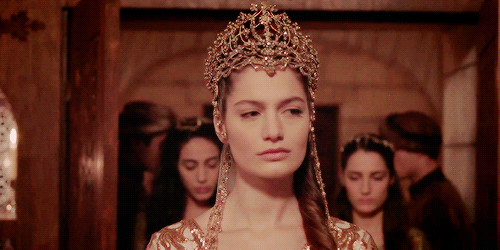
Ismahan sultan 1545-1585
Daughter of Selim and Nurbanu,she was married to Sokollu Mehmed Pasha and Through her husband and her own rank, Esmehan was the most influential sultana of the empire for years. In wealth, only her aunt, Mihrimah, could overtake her, but in influence, almost no one could. She constructed several projects and had foreign diplomatic affairs, most notable her correspondence with Catherine de Medici. She had a very artistic and dramatic personality, often throwing parties and shows. She was recorded to be very much alike Hurrem,both of them were short, not conventionally beautiful,but very intelligent. She was heavily involving herself in politics with her mother.
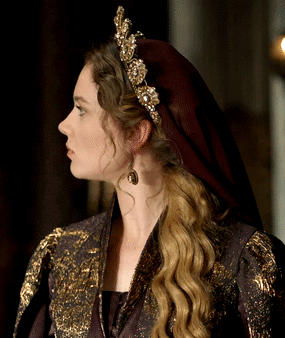
Burnaz Atike Sultan
Sultan Atike was born in 1614 or 1615 and although some sources consider her to be the daughter of Kösem, she was certainly not her child. That can be supported by the fact that she supported Turhan’s rebellion and had a good relationship even after kosem was killed. She was one who raised Turhan and remained in friendly terms for both Turhan’s gratitude and their shared politican views. Atike was noted to love children very much,but had none on her own, so she was involved in raising her nephew,who regarded her as second mother and listened to every of her advice.
She died around 1570.
I hope you liked it, I think it’s unfair to only talk about Mihrimah,while there were so many powerful and intelligent Princesses. I did not talk about Esma sultan as she was in later centuries and I am not fond of her times.
Which ottoman princesses are you favourites?
If i accedentaly missed something out you can ask it in comments
#historical drama#period drama#history#sultanas#valide sultan#medieval women#nurbanu sultan#hurrem sultan#mihrimah sultan#safiye sultan#kosem sultan#turhan sultan#magnificent century#magnificent century kosem#mc: kosem#sultanate of women#sultan suleyman#haseki hurrem sultan#ottoman history#ottomanladies#ottoman empire#15th century#16th century#17th century
125 notes
·
View notes
Text

~The last Haseki Sultan~
Rabia was the consort of Ahmed II. Her date of birth and origin are unknown.On 7th October 1692, Rabia gave birth to twin şehzades Selim and Ibrahim. Sultan Ahmed II ordered huge festivales. On 14th November 1692, the Sultan rewarded Rabia with the title of Haseki Sultan and he made her wear a crown. Thus, Rabia became the last Haseki Sultan of the Ottoman Empire. Sadly, Şehzade Selim passed away on 15th May 1693. In July 1693, the mansion of late Kara Ibrahim Pasha, grand vizier during the reign of Mehmed IV, was donated and assigned to Rabia. On 23th October 1694, Rabia gave birth to her only daughter, Asiye. Ahmed II granted Rabia lands in Aleppo. Property of Ahmed's sister, Gevherhan Sultan who passed away in September 1694, was given to Asiye Sultan. It is understood from the documents,that late Gevherhan Sultan was in debt, especially the debt she owed Rabia was high. After Ahmed II passed away in Februar 1695, Rabia and Asiye left Edirne and moved to Istanbul to the Old Palace. Rabia's son Ibrahim stayed in Edirne, in care of the new Valide Sultan , Emetullah Rabia Gülnuş. Unfortunatelly, Asiye passed away on 9th December 1695. Nothing else is known about Rabia's life in the Old Palace. We can only imagine how devasted she was after loosing two of her childern, her master and beeing far away from her only living child. Rabia passed away on 14th January 1712. 370 kuruş ( ca. 4320 $) were spent on her funeral. Rabia rests next to Ahmed II, in Sultan Süleyman's tomb
youtube
8 notes
·
View notes
Photo






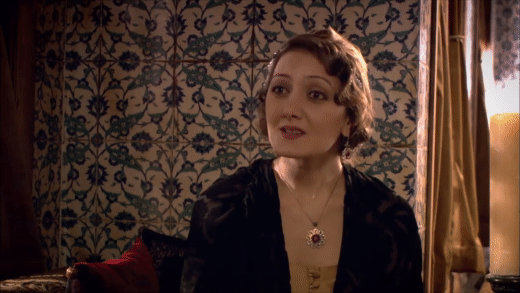
Sisters in Muhtesem Yuzyil
Row 1: Fatma Sultan and Sah Huban Sultan
Row 2: Esmahan Sultan, Gevherhan Sultan and Sah Sultan
Row 3: Hatice Sultan and Beyhan Sultan
#Sister#Sisters#muhtesem yuzyil#magnificent century#fatma sultan#sah huban sultan#hatice sultan#beyhan sultan#sah sultan#gevherhan sultan#esmahan sultan#historical drama#historical tv#historical characters#historical sisters#period drama#period dramas#daughters of selim I#Daughters of Selim II#sultana#born sultana#born sultanas#born sultans
26 notes
·
View notes
Text
Sultanate of Women (3/7)
Nurbanu Sultan (c.1525/ 7 December 1583)

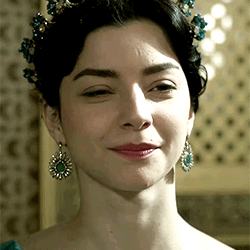
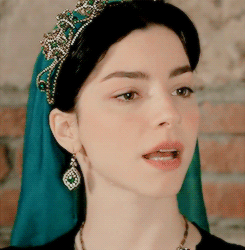
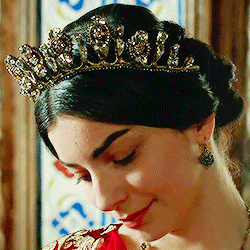
Daughter of Nicolo Venier and Violanta Baffo
Haseki Sultan (Legal Wife) of Sultan Selim II and Valide Sultan of Sultan Murad III
Mother of Sultan Murad III, Sah Sultan, Ismihan Sultan, Gevherhan Sultan, and Fatma Sultan
Grandmother of Sultan Mehmed III, Sehzade Mahmud, Sehzade Mustafa, Sehzade Oman, Sehzade Bayezid, Sehzade Selim, Sehzade Cihangir, Sehzade Abdullah, Sehzade Ahmed, Sehzade Yakub, Sehzade Alemsah, Sehzade Yusuf, Sehzade Hüseyin, Sehzade Korkud, Sehzade Ali, Sehzade Ishak, Sehzade Alaeddin, Sehzade Davud, Sehzade Suleiman, Sehzade Yahya, Hümasah Sultan, Ayse Sultan, Fatma Sultan, Mihrimah Sultan, Rukiye Sultan, Mihriban Sultan, and Fahriye Sultan.
Mother-in-law of Çakırcıbaşı Hasan Pasha, Zal Mahmud Pasha, Sokullu Mehmed Pasha, Kalaylıkoz Ali Pasha, Safiye Sultan, Piyale Pasha, Cerrah Mehmed Pasha, and Kanijeli Siyavuş Pasha
Fun Fact For Newbies: Nurbanu Sultan was born Cecilia Venier-Baffo
47 notes
·
View notes
Photo






Legal Wives in Magnificent Century: Haseki Afife Nurbanu Valide Sultan
Born Cecilia Venier-Baffo in Paros, Republic of Venice; daughter of Niccolo Venier and Violanta Baffo. She was the legal wife of Sehzade Selim (later Sultan Selim II) and Haseki of the Ottoman Empire, and mother of Sehzade Murad (later Sultan Murad III), Esmahan Sultan, Sah Sultan and Gevherhan Sultan. Also was the first slave to be Valide Sultan of the Ottoman Empire.
#lwinmc#Nurbanu Sultan#magnificent century#perioddramaedit#muhteşem yüzyıl#muhtesem yuzyil#mcedit#magnificentedit#my gifs
210 notes
·
View notes
Note
Was Selim II monogamous too ? Can you please give us some interesting facts about Nurbanu and Selim's relationship like you did with her son Murad and his consort Safiye
When it comes to his princely years it’s debatable, after he ascended the throne he surely produced several sons that had mothers other than Nurbanu. Actually, Nurbanu didn’t give birth to any more children after Selim became sultan, but similarly to Safiye she remained the closest woman to her padişah and received the highest stipend. Other mothers of Selim’s sons don’t even have their names mentioned in register, they are only referred to as “mother of prince X”. Nurbanu definitely established her position during Selim’s princely years, likely managing his harem, since Hürrem stayed in capital.
Leslie Peirce originally wrote in the Imperial Harem that Selim and Mustafa (in contrast to Bayezid and his large family) practiced reproductive monogamy during their princely years, but she contradicted it in her newest publication, the Empress of the East:
This prince [Mustafa] was not a prolific reproducer, however, at least in comparison to his half brother Selim, who would have three concubines pregnant not long after his arrival in Konya.
Later she mentions that:
Both she [Hurrem] and Cihangir were doubtless delighted to meet the three daughters who had been born to the prince in his first year as governor in Anatolia. The mother of one, Nurbanu, would go on to become Selim’s favorite consort and mother of his first son, Murad.
And:
Selim left behind the onetime experience of a politically active queen working alongside a monogamous king and its perhaps unintended corollary, a mother dividing her loyalty among several princes. Selim did, however, establish a favorite: Nurbanu, mother of his first son, Murad. He was far from monogamous; nor was she celebrated as his queen, although he allegedly married and dowered her.
Curiously, Öztuna thinks that three daughters usually attiributed to Nurbanu, i.e. Ismihan, Gevherhan and Şah, were these three daughters born in the same year and Nurbanu was only mother of one, Ismihan. He also claims that Nurbanu’s other children were Murad (indisputable) and Fatma (disputable, as I will later discuss). Most scholars cite Nurbanu as mother of Gevherhan and Şah too, so I’d stay with that, though we have no names provided for those other two daughters born to Selim during his first year in Konya. It is however possible that their names got lost, especially if they didn’t survive infancy, which could be very likely the case. As for Fatma Sultan - Peirce contests Uluçay’s claim that Fatma was Nurbanu’s daughter:
The birth of Fatma to Selim II in 1559, which appears as an anomoly in the productive politics of the times as I have reconstructed them, may make some sense from this perspective. Nurbanu’s son Murad left for the provinces in 1558; if her sexual role ceased at that point, Fatma may have been the result of Selim’s new relationship with another concubine. This was probably an unintended birth, since no other children appear to have been born between 1546 (the year of Murad’s birth) and Selim’s accession in 1566. The attempt to induce Murad III to give up his monogamous relationship with Safiye seems to have intensified around the time Safiye’s son Mehmed took up his post (1582).
Some quotes from ambassadors about Nurbanu and Selim’s relationship:
Venetian ambassafor Jacopo Soranzo in 1566:
“the Chassechi [haseki]…. is said to be extremely well loved and honored by His Majesty both for her great beauty and for being unusually intelligent.”
Venetian ambassafor Andrea Badoaro in 1573 (so a year before Selim’s death)
“she is called the cassachi and is much loved by his majesty.”
Venetian ambassafor Marino Cavalli in relation to Venetian Senate 1568 (he was an ambassador in Istanbul from 1557 to 1559):
“Among many women possessed by this Signor, there is one who is truly and properly his wife, like La Rossa was to Solimano, his father… For what is being circulated, she is a Corfiote subject of your Seignory, a Noble Venetian, as some would emphasize. She is a wise woman and has a single son with the Signor, called Sultan Murath, who is currently twenty-one years of age”.
Jacopo Ragazzoni mentioned that Selim married her, bestowing a dowry of 100,00 ducats.
She received much higher stipend than mothers of other Selim’s sons - 1,000 aspers a day, while all the others only 40 aspers a day (bear in mind that her son was also clearly singled out as heir to the throne). Nurbanu was also the first concubine to be buried in the tomb of the sultan that used to be her master.
- Joanna
48 notes
·
View notes
Photo


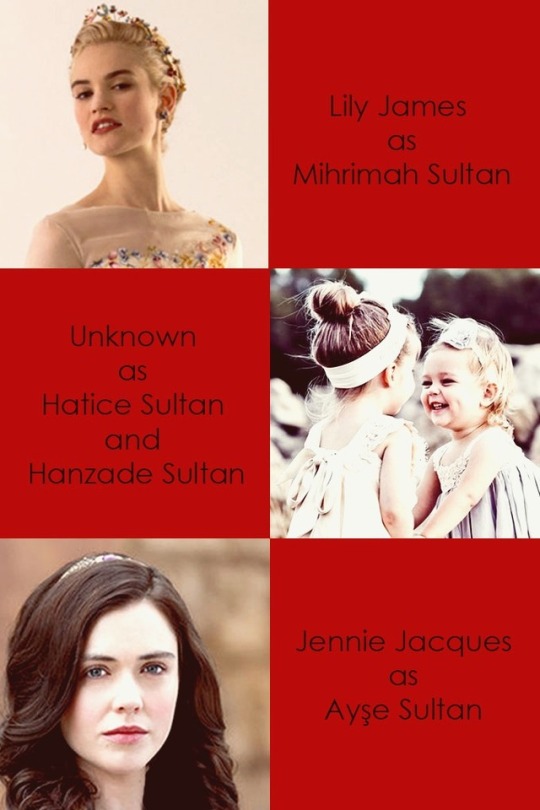
Muhteşem Yüzyıl (Magnificent Century) fancast: Daughters of Hürrem Haseki Sultan. Second generation.
1. Hümaşah Sultan (1540-1593) - daughter of Şehzade Mehmed of the Ottoman Empire.Like her cousin Ayşe Hümaşah Sultan, she was reportedly beloved by their grandfather, to whom she wrote letters.She is regarded amongst the most influential women of Suleiman's reign.This affection can be explained, in large measure, by the fact that her late father, Mehmed, was Suleiman's favorite son. It was she who, in 1563, gifted her cousin Şehzade Murad (future Sultan Murad III) with a concubine that would go on to be Safiye Sultan.
2. Ayşe Hümaşah Sultan (1541–1594) - daughter of Mihrimah Sultan of the Ottoman Empire and Rüstem Pasha. She was her parents' first child and only daughter, and possibly her grandparents' first grandchild as well. She had several brothers, whose number and names are though contested.
3. Ismihan Sultan (1544 – 1585) - daughter of Selim II and Nurbanu Sultan. She was the most powerful daughter of Selim II because she was married to the Grand Vizier Sokollu Mehmed Pasha. She is famous for having built the Sokollu Mehmed Pasha Mosque and Esmahan Sultan Mosque.
4. Gevherhan Sultan (1544 - after 1604) - daughter of Sultan Selim II and Nurbanu Sultan. Soon after his succession, Mehmed's son by Handan Sultan, Ahmed I wanted to express his gratitude to Mehmed Pasha and Gevherhan Sultan for the role they had played in bringing his parents together. He also named one of his daughters after her.
5. Şah Sultan (1545 – 1580) - daughter of Selim II and Nurbanu Sultan. The union of Şah Sultan to Zal Mahmud is said to be a very happy one. They were suited to each another. It was said that, that they fell ill at the same time, lay in their deathbeds together, and expired at the same very moment.
6. Fatma Sultan (1559–1580) - daughter of Sultan Selim II. Fatma was born in 1559,during Selim's princedom, at Konya or Karaman where he served as sanjakbey, or provincial governor, at the time.
7. Mihrimah Sultan (1547 – 1594) - daughter of Şehzade Bayezid. Married in 1562 to Damat Müzaffer Pasha.
8. Hatice Sultan and Hanzade Sultan (1550/1556-?) - daughters of Şehzade Bayezid.
9. Ayşe Sultan (1553- 1572) - daughter of Şehzade Bayezid. Married in 1562 to Damat Hoca Ali Pasha Eretnaoğlu.
#hurrem sultan#magnificent century#muhteşem yüzyıl#Mihrimah Sultan#nurbanu sultan#sultan suleyman#perioddramaedit
35 notes
·
View notes
Text
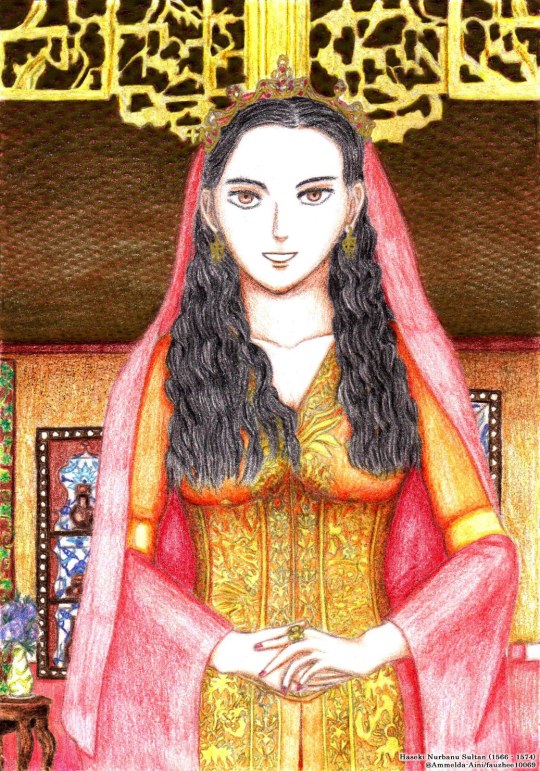
Haseki Nurbanu Sultan (Muhtesem Yuzyil) by Ammelda-Aini
Haseki Afife Nurbanu Sultan (tenure: 1566 - 1574) was Haseki Sultan of the Ottoman Empire as the principal consort and later legal wife of Sultan Selim II (reign 1566–1574), and later Valide Sultan as the mother of Sultan Murad III (reign 1574–1595). In Muhteşem Yüzyıl, she was Venetian origin and her birth name was Cecilia Venier-Baffo. While her spouse Selim still a şehzade, Nurbanu had been the head of his princely harem at Manisa. However, when Selim ascended to the throne, she was not head of the imperial harem, as that was a position taken by Selim's elder sister Mihrimah Sultan. Nurbanu acted as an advisor to her husband. Although it was far from normal at the time, Selim II would often ask Nurbanu for her advice on various subjects because of his respect for her good judgment. Like his predecessor Selim let his favorite wife remain at Topkapı throughout his reign.[11] She had four children with Selim II: Sultan Murad III, Ismihan Sultan, Gevherhan Sultan, and Şah Sultan.
Further information: Afife Nurbanu Sultan.
I drew Nurbanu with anime/manga style. Her design here taken from Turkish historical drama "Muhteşem Yüzyıl" (starred by Merve Boluğur):


The next one will be featured Safiye Sultan, Nurbanu's daughter-in-law.
Previous work: Haseki Hürrem Sultan.
1 note
·
View note
Note
Also she said in terms of rank, the Dynasty Sultanas are placed above the Valides and the Hasekies (Something I agree with) Because after all the dynasty sultanas were free women who were not part of the institution of the harem and had imperial blood, but the Valides and the hasekies were slaves.
I can't see a dynasty sultana like Mihrimah bowing to Valide Nurbanu or Dynasty Geverhan Sultan Bowing to Handan.
For me the hierarchy is:
-Older Sultanas (ex: Mihrimah, Gerverhan, Atike..) -Valid Sultanas (eg: Nurbanu, Hadan, Turhan) -Younger Sultanas (ex: Ayse Humashah, Sah Huban, Esmehan)
-Haseki Sultan
-Bas Hatun
-Hatun
I placed the young sultanas under of the Valide Sultans because we are in a Muslim society so elders are very respected. In the case of Humaşah Sultan (Daughter of shezade Mehmed) and Valide Nurbanu Sultan, I think that Humaşah out of respect bowed to Nurbanu since she was her senior and the Valide Sultan.
Both age and title played an important factor to who should bow to who.
No, I'm sorry but I disagree with you two.
The Valide Sultan was the custodian of the dynasty, she was the "elder" not because of her age but because she was a) the mother of the sultan and b) a woman in her post-sexual role.
Now, sexuality was very important in the Ottoman Empire: a woman who didn't have sexual intercourse anymore was considered mature (not in terms of age).
It doesn't matter how old the Valide Sultan was, she was the most mature member of the dynasty (by association, because she had given birth to the sultan).
I understand your reasoning about the princesses being born free but they were still subjected to the Valide Sultan's authority. I also understand why you'd think Mihrimah would not bow to Nurbanu but I think Gevherhan and Handan are a different case altogether because Gevherhan had raised Handan in her household, maybe they had a different relationship because of this.
For example, I think Bayezid II's daughters (and therefore Selim I's sisters) bowed to Ayşe Hafsa.
2 notes
·
View notes
Text
Portrait of Rabia Sultan / Rabia Sultan portréja
The Last Haseki
Rabia may have been born around or after 1670, but neither her origin nor her date of birth is known. We know nothing about her early life. Following his two brothers, in 1691 Ahmed II ascended the throne. The mother of the aging sultan had already died before his accession to the throne, so the first woman of the harem became Rabia, the sultan’s favorite consort. In October 1692, Rabia's first children, twin boys, were born in Edirne. It was the first surely documented twin birth in the history of the Empire. The boys were named Ibrahim and Selim. After their birth, the sultan arranged a party for four days and nights and piled up a lot of gifts for his sweetheart, and certainly gave her the rank of Haseki at that time as well.
In 1693, Prince Selim died. In October 1694, Rabia gave birth to another child, Asiye Sultan, after which Rabia received even more estate and gifts from the Sultan. Rabia was in possession of astonishing wealth, and even the true-born sultanas asked her for financial help if they were needy. It is known that Ibrahim I’s daughter, Gevherhan, who was Rabia’s sister-in-law, also repeatedly applied for a loan from the Haseki.
The radiance of Rabia did not last long, in 1695 Ahmed II died and was replaced by Mustafa II. This was tantamount to Rabia’s retreat to the Old Palace, where her daughter died in December of the same year. Her only surviving son was Prince Ibrahim, who, however, did not live with her but in the court of the new sultan.
Rabia died on January 14, 1712, in the Old Palace and was buried next to her sultan. Rabia is one of the Hasekies with the most tragic fate in the history of the Empire. As mesmerizing, uplifting, and long was the reign of the first Haseki, Hürrem, as tragic, sad, and short was the reign of the last Haseki, Rabia.

Used sources: M. Ç. Uluçay - Padişahların Kadınları ve Kızları; N. Sakaoğlu - Bu Mülkün Kadın Sultanları
* * *
Az utolsó Haseki
Rabia 1670 körül születhetett, ám sem származása sem születési ideje nem ismert. Korai életéről nem tudunk semmit. II. Ahmed két bátyját követve, 1691-ben lépett trónra. Az idősödő szultán édesanyja már trónralépése előtt meghalt, így a hárem első asszonya Rabia, a szultán kedvence lett. 1692 októberében Edirnében születtek meg Rabia első gyermekei, egy fiú ikerpár. Ez volt az első biztosan dokumentált ikerszülés a birodalom történetében. A fiúk az Ibrahim és Szelim nevet kapták. A szülés után a szultán négy napon és éjjelen át tartó partit rendezett és rengeteg ajándékkal halmozta el kedvesét és minden bizonnyal a Haseki rangot is ekkor adományozta neki.
1693-ban Szelim herceg sajnálatos módon elhalálozott. 1694 októberében Rabia újabb gyermeknek adott életet, Asiye szultánának, mely esemény után Rabia még több birtokot és ajándékot kapott a szultántól. Rabia elképesztő vagyon felett rendelkezett, még a született szultánák is az ősegítségér kérték ha megszorultak. Ismeretes, hogy I. Ibrahim lánya, Gevherhan, aki Rabia sógornője volt, szintén többször kért kölcsön a Hasekitől.
Rabia ragyogása nem tartott sokáig, ugyani 1695-ben II. Ahmed elhunyt, helyére II. Musztafa lépett. Ez egyet jelentett Rabia visszavonulásával a Régi Palotába, ahol ugyanebben az évben, decemberben kislánya elhunyt. Egyetlen életben maradt fia, Ibrahim herceg volt, aki azonban nem vele élt, hanem az új szultán udvartartásában.
Rabia 1712 január 14-én hunyt el a Régi Palotába és kedvese mellé temették. Rabia az egyik legtragikusabb sorsú Haszekije a birodalom történetének. Amilyen ragyogó, felemelő és hosszú volt az első Haseki, Hürrem szultána uralkodása, olyannyira volt tragikus, szomorú és rövid az utolsó Haseki, Rabia szultána uralma és egész élete.

Felhasznált források: M. Ç. Uluçay - Padişahların Kadınları ve Kızları; N. Sakaoğlu - Bu Mülkün Kadın Sultanları
33 notes
·
View notes
Text
Kosem Sultan By Solmaz Kamuran
Book Name
Kosem Sultan (کوسم سلطان)
Author Solmaz Kamuran
Book Publishers ?
Language. Urdu
Category Novel History
Book Code 119
Paper Black
Pages ?
Rs 800
Rs 700
Book Quality Paper Black
Whatsapp +92312-9775152
E-mail [email protected]
ABOUT
معروف ترک ادیبہ، مترجم اور کالم نگار سولمازکاموران (Kosem Sultan) استنبول میں 1954ءمیں پیدا ہوئیں۔ زیرنظر کتاب ”کوسم سلطان“ اُن کے ناول (Kosem Sultan) کا اردو ترجمہ ہے۔ اس ناول کی کہانی، تاریخ اور تخیل کے امتزاج پر مبنی ہے۔
عثمانی سلطان احمت 1603ءمیں اپنے والد محمت سوم کی بے وقت موت کے بعد تخت نشیں ہوا اور یہیں سے اس کہانی کا آغاز ہوتا ہے۔ ناول کا مرکزی کردار ”کوسم“ ہے جس کا تعلق یونانی جزیرے تینوس سے تھا۔ پندرہ برس کی عمر میں اغواکاروں نے اسے بوسنیا کے گورنر کے ہاتھ فروخت کیا جہاں سے وہ عثمانی شاہی حرم میں بھیج دی گئی۔ وہ عثمانی سلطان احمت کی منظورِنظر کنیز اور بعدازاں قانونی بیوی بنی۔ وہ دو عثمانی سلاطین سلطان مراد چہارم اور سلطان ابراہیم کی ماں، اور سلطان محمت چہارم کی دادی تھی۔
سلطان سلیمان عالیشان کے بعد سولہویں اور سترہویں صدی عیسوی میں 130سال سے زائد عرصہ عثمانی سلطنت پر شاہی حرم کی خواتین کی درپردہ حکومت رہی جو سلاطین کی منظورِنظر خواتین یا نوعمر سلاطین کی ماﺅں کی حیثیت سے ریاستی معاملات میں بے پناہ سیاسی اثرورسوخ رکھتی تھیں۔ اس کا ایک سبب برادرکشی کی روایت بھی تھی۔ سلطان محمت نے تخت نشینی کے بعد اپنے 19 بھائیوں کا سر قلم کیا تھا۔
کوسم سلطان، سلطنت عثمانیہ کی طاقتور ترین خاتون تھی۔ وہ دو مرتبہ نائب سلطنت رہی۔ ”خواتین کی سلطنت“ کی یہ ممتازترین شخصیت اپنے قتل کے بعد لوگوں میں ”والدہ مقتول“ اور ”شہید والدہ“ کے نام سے جانی گئی۔ سلطنت عثمانیہ کے پایہ¿ تخت استنبول کی گلیوں میں کئی روز تک اس کے بے رحمانہ قتل کا ماتم کیا جاتا رہا۔
Famous Turks, translators and columnists, Kosem Sultan, were born in Istanbul in 1954. The book "Undermine Sultan" is a translation of Urdu's translation of Kosem Sultan. The story of this novel is based on the combination of history and imagination.
Ottoman Sultan Ahmat was throne after the death of his father Mohmat Som in 1603, and this story starts from here. The novel's role is "Kosmos", which belonged to the Greek island of Tunisia. At the age of fifteen, the abductors sold him to the governor of Bosnia, where he was sent to the Ottoman royal palace. They were Kansen and later legal lawmakers in view of Ottoman Sultan Ahmet. He was the grandmother of two Ottoman slants Sultan Murad IV and the mother of Sultan Ibrahim, and Sultan Mohmat IV.
After Sultan Sulman Islashan, in the sixteenth and seventh centuries CE, more than 130 years of Ottoman Empire embedded in the dominant government of the royal hammers, who had a political influence in the state affairs as a mothers of women or teenagers, in view of the slavery. One reason for this was also the tradition of a brotherhood. Sultan Talmat had headed his 19 brothers after the throne.
Kausar Sultan was the powerful woman of Ottoman Empire. He was twice the Vice Empire. This prominent personality of "Women's Empire" was named after the "mother of death" and "martyrdom" in his people after his death. During the streets of Ottoman Empire, the Ottoman Empire of Ottoman, many unhealthy murders were mourned for many days.
Nothing bad, but there is a Kosen Sultan who appears to hold the Guinness record for being the world’s tallest man, so not to be confused.)
In reality, the harem was an enclosed space for the women of the royal household, etymologically derived from the Arabic haram—forbidden—which allowed elite women to live in seclusion and yet still have access to and even exert control over the seat of power. In the Ottoman Empire, the women of the harem could be very influential, even enjoying a period in the 16th and 17th centuries known as the “Sultanate of Women” when, through regencies and political strategizing, they were practically in charge. It’s worth noting that this partly coincided with the height of the Empire’s power.
Kösem Sultan is one of the most extraordinary of these women. Born on a small Greek island around 1585, she eventually made her way to Constantinople at age fifteen, sold into the harem of the Ottoman Sultan Ahmed I, where she became a favorite of his and then became one of his wives.
Ahmed died in 1617, and in 1623 Kösem’s son Murad IV became Sultan and Kösem became Valide Sultan, or Mother of the Sultan. Because Murad was a minor, Kösem was his official regent—the first woman to ever rule the Ottoman Empire and one of only two who ever would. She was regent for nine years.
Now, as I hinted at earlier, the Ottoman Empire in this period was nothing to sneeze at. Its subjects numbered around thirty million, and its reach extended across North Africa, Eastern Europe, and most of what we now know as the Middle East. Like many empires, it could have probably quit while it was ahead circa 1550, but continued to expand and was mostly still doing A-OK until 1683, when the Ottomans whiffed at the disastrous siege of Vienna, undertaken by Grand Vizier Kara Mustafa Pasha.
Kosem Sultan (کوسم سلطان)
Born: Tinos, Greece
Died: 2 September 1651, Constantinople
Buried: Sultan Ahmed Mosque, Istanbul, Turkey
Spouse: Life Patterns
↓
Ahmed I was the Sultan of the Ottoman Empire from 1603 until his death in 1617. Ahmed's reign is noteworthy for marking the end of the Ottoman tradition of royal fratricide; henceforth Ottoman
Son Of Kosem Sultan (کوسم سلطان)
1. Murad IV
Murad IV was the Sultan of the Ottoman Empire from 1623 to 1640, known both for restoring the authority of the state and for the brutality of his methods. Murad IV was born in Istanbul, the son of Sultan Ahmed I and the ethnic Greek Kösem Sultan
مراد IV سلطنت سلطنت عثمان سلطنت 1623 سے 1640 تک تھا، دونوں ریاستوں کو ریاستی اور ان کے طریقوں کے ظلم و امان کے بحال کرنے کے لئے جانا جاتا تھا. مراد IV میں استنبول، سلطان احمد I اور نسلی یونانی کوسم سلطان کے بیٹے پیدا ہوئے
2. Ibrahim
Ibrahim was the Sultan of the Ottoman Empire from 1640 until 1648. He was born in Constantinople the son of Ahmed I by Valide Kösem Sultan, an ethnic Greek originally named Anastasia
ابراہیم عثمان سلطنت کی سلطان 1640 سے 1648 تک تھی. وہ پیدا ہوئے تھے، احمد احمد کا بیٹا کنڈننولوال میں ویلڈ کوسم سلطان، ایک اصل یونانی اصل میں اناساساسیا کے نام سے
3. Şehzade Kasım
Born: 1614, Istanbul, Turkey
Died: 17 February 1638, Istanbul, Turkey
4.Şehzade Suleiman
Born: 1613, Istanbul, Turkey
Died: 27 July 1635, Topkapı Palace, Istanbul, Turkey
5. Şehzade Mehmed
Born: 8 March 1605, Topkapı Palace, Istanbul, Turkey
Died: 12 January 1621, Istanbul, Turkey
6. Şehzade Orhan
Born: 1609, Istanbul, Turkey
Died: 1612, Istanbul, Turkey
7. Şehzade Sultan Selim
Murad IV's brother
Born: 27 June 1611, Istanbul, Turkey
Died: 27 July 1611, Istanbul, Turkey
8. Gevherhan Sultan
Gevherhan Sultan was an Ottoman princess, daughter of Sultan Ahmed I and Kösem Sultan, half-sister of Sultan Osman II, and sister of Sultans Murad IV and Ibrahim of the Ottoman Empire. Wikipedia
Born: 1608, Istanbul, Turkey
Died: 1660, Istanbul, Turkey
9. Burnaz Atike Sultan
Burnaz Atike Sultan was an Ottoman princess, daughter of Sultan Ahmed I, half-sister of Sultan Osman II, and sister of Sultans Murad IV and Ibrahim of the Ottoman Empire.was an Ottoman princess. Wikipedia
Born: 1614, Istanbul Province, Turkey
Died: 1674, Istanbul Province, Turkey
10.Hanzade Sultan
Kösem Sultan's daughter
Hanzade Sultan was an Ottoman princess. She was the daughter of Sultan Ahmed I and Kösem Sultan. She was a sister of Osman II, Murad IV and Ibrahim, and the paternal aunt of Mehmed IV. Wikipedia
Born: September 1607, Istanbul, Turkey
Died: 21 September 1650, Istanbul, Turk
11. Ayşe Sultan
Daughter of Ahmed I
Image result for Ayşe Sultan
Ayşe Sultan was an Ottoman princess, daughter of Sultan Ahmed I and Kösem Sultan, half-sister of Sultan Osman II and sister of Sultan Murad IV and Sultan Ibrahim of the Ottoman Empire. Ayşe is known for her many politically motivated marriages. Wikipedia
Born: 1605, Constantinople
Died: May 1657, Istanbul, Turkey
12. Fatma Sultan
was an Ottoman princess. She was the daughter of Sultan Ahmed I and Kösem Sultan, sister of Murad IV and Ibrahim, and the paternal aunt of Mehmed IV. She is known for her many political marriages. Wikipedia
Born: 1606, Istanbul, Turkey
Died: 1670, Istanbul, Turkey
13. Cemre Sultan
Kösem Sultan's daughter
Born: 1616, Istanbul, Turkey
Parents: Kösem Sultan
via Blogger http://ift.tt/2BPACoe
1 note
·
View note
Text

Handan was born in Bosnia around 1570. She was educated by Gevherhan Sultan, daughter of Sultan Selim II. She was giftet to prince Mehmed future Mehmed III. Handan gave birth to at least 4 childern. She was the mother of Ahmed I.Handan was the first female co-regent of the ottoman empire since her son Ahmed I ascended the throne as 13 years old teenage-boy. Ahmed didn't serve in province so he wasn't able to build alliances. In the first months of Ahmed's reign, Ahmed, Handan, grand vezir Ali Pasha and Ahmed's teacher Mustafa efendi met to discuss state affairs. The three men spoke face to face while Handan stayed behind the spanish wall. Few months later Handan steped back from politics and her salary was reduced. The whole thing is probably Handan's idea because she wanted Ahmed to be the opposite from his late father Mehmed III, who was overruled by his mother, Safiye Sultan. It is a known fact that Safiye was hated by soliders and even common people, so Handan suggested that Ahmed I sends her to the old palace. Handan had healthissues. In 1605 her situation worsened, especially after Ahmed executed one of her trusted men, Sinanpashaoglu Ahmed Pasha (son in law of Gevherhan Sultan who raised Handan)
On 9th November 1605, Valide Handan Sultan died, she is burried in Hagia Sofia, in Mehmed III's masoleum.
7 notes
·
View notes
Note
Thanks for your last answer, buddy. But I was expecting to hear your own explanation as you are studying it for a long time. However, it is okay. Can you please tell us what is the stipend of sultanzade and hanimsultan?
Oh well, I definitely haven't studied this for longer than Leslie Peirce, who is a professor. I put her quote in my answer to you because I think that's the reason why Handan's stipend was comparably lower than Safiye's, who kept receiving 3,000 aspers a day until she died.
I don't know about Sultanzades, but Hanımsultans are a complicated matter: in general, their stipend depends on whether they're related to the reigning sultan or not, and whether they're princesses of the Enderûn (Inner palace) or Bîrûn (Outer palace).
(Enderûn means that they had lived - sometimes in their lives - in an Imperial Palace — Topkapi or the Old Palace —, Bîrûn that they had never lived in an imperial palace and were, therefore, third-generation princesses)
During Süleyman I's reign the general rule was that adult and married daughters of sultans received 200 aspers per day and granddaughters of sultans received 100 aspers, it didn't matter whether they were related to the Imperial family through their father (and were, therefore, Sultans) or through their mothers (and were Hanımsultans)
Examples:
(table is from Les Perles de Nacre du Sultanat by Juliette Dumas and is dated November 1555 - November 1556)
I know the table is in French but I think it's quite self-explanatory. For the sake of our argument, we'll take a look at the first row only: émoluments, which are the fixed stipends

Both Şehzâde and Şâh Sultan were daughters of Selim I's and therefore Süleyman I's sisters: they receive the same stipend. What is interesting is that both Ismihan Sultan and Ayşe Hanımsultan receive the same stipend: the former descends from a prince, the latter from a princess (the aforementioned Şehzâde)
(notice that Ayşe Hanımsultan is called Ayşe Sultan in harem registers. As I have said many times, Süleyman I's reign is a period of both revolution and stabilisation for women's titles)
Now onto princesses of the Bîrûn (in the same time-lapse: November 1555 - November 1556):

We're going to focus on the last three princesses. As you can see the one descending from a male has a slightly higher stipend than the two descending from a female.
The hierarchy of princesses in the XVI century was, therefore:
daughters of sultans
granddaughters of sultans
great-granddaughters descending from a male (ie. a prince)
great-granddaughters descending from a female (ie. a princess)
As you can see for Mihri Hatun, the daughter of a Hanımsultan did not have a title but still received a stipend from the Imperial treasury. Mihrî Hatun's descendants were considered complete commoners and did not have a tie to the Dynasty.
Fast forward to the beginning of the XVII century and we can see that the hierarchy has become more complex:
this table is dated May 1603 - May 1604, between Mehmed III's and Ahmed I's reigns

As you can see here, the first three princesses — Gevherhan, Ayşe and Fatma — are all daughters of sultans but Ayşe and Fatma are daughters of the reigning Valide Sultan and therefore receive a higher stipend. Dumas incorrectly identifies Gevherhan as a daughter of Murad III's with an unknown concubine but she's actually Selim II's daughter (which is why she's mentioned first after the two valide sultans— she's the eldest princess alive)
What we need to focus on — for the sake of our argument — though are the princesses I have circled: Ayşe Sultan, widow of Ahmed Paşa is actually Ayşe Hümâ-Şâh, Mihrimah's daughter. Hatice Sultan, is the daughter of Gevherhan and therefore granddaughter of Selim II.
Technically, Hatice and Ayşe Hümâ-Şâh have the same rank: they're granddaughters of sultans. So why the different stipends? Ayşe Hümâ-Şâh benefits from her mother's "aura". Mihrimah Sultan was the "greatest princess of the empire", with a lofty stipend of 600 aspers a day during Murad III's reign (when she died). For context, Safiye received 700 aspers as Haseki.
No princess would ever earn so much.
The 6 şehzâdegân (which just means 6 princes/princesses) may be Mehmed III's daughters, who were unmarried and therefore their stipends were low (in very practical terms: as they did not have a household to manage because they lived in a room inside Topkapi, they didn't need a higher stipend)
The hierarchy of princesses at the beginning of the XVII century was, therefore:
princesses born from the haseki sultan who subsequently became valide sultan
the other princesses, born from non-haseki concubines
granddaughters who benefit from their mothers' rank
the other granddaughters
great-granddaughters
As Dumas concludes:
Contrary to the Ottoman principle of blood transmission, which (officially) only takes into account the paternal lineage, the importance of mothers predisposes their daughters to a certain preponderance over their half-sisters. The hierarchy also tends to produce a stronger distinction between daughters and granddaughters (between sultans or hanım sultans) and the third generations, put a little jumbled up in a sub-category that annihilates any individual specificity.
If you're interested, this is what a harem register looked like:
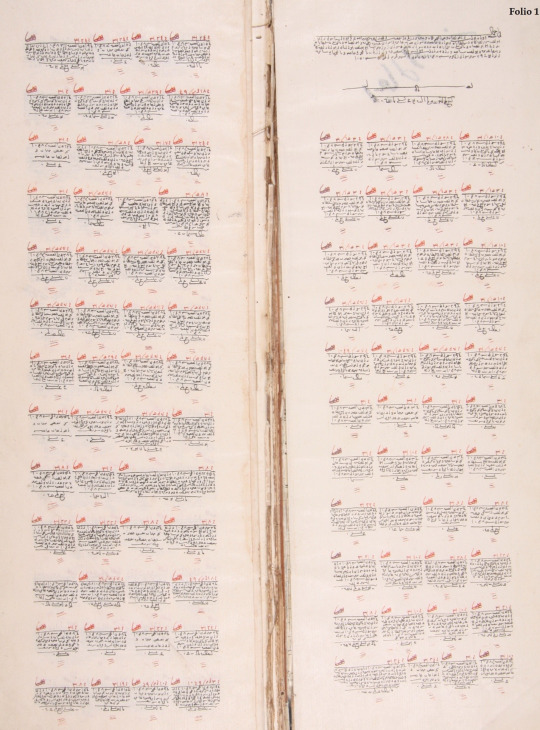
In the XVI century, the stipend of Şehzades was 100 aspers when they resided in the Palace. I guess the stipend of Sultanzades paralleled those of Hanımsultans.
#ask post#ask: ottoman history#ottoman harem#ayse humasah hanimsultan#sehzade sultan daughter of selim i#sahihuban sultan daughter of selim i#gevherhan sultan daughter of selim ii#ayse sultan daughter of murad iii#fatma sultan daughter of murad iii#kadinlarsaltanati
43 notes
·
View notes
Photo






𝐭𝐡𝐞 𝐠𝐫𝐚𝐧𝐝𝐝𝐚𝐮𝐠𝐡𝐭𝐞𝐫𝐬 𝐨𝐟 𝐒𝐮𝐥𝐞𝐲𝐦𝐚𝐧 𝐭𝐡𝐞 𝐌𝐚𝐠𝐧𝐢𝐟𝐢𝐜𝐞𝐧𝐭
#history#historyedit#ottoman history#suleyman i#nergissah sultan daughter of sehzade mustafa#ayse humasah sultan#humasah sultan daughter of sehzade mehmed#ismihan sultan daughter of selim ii#gevherhan sultan daughter of selim ii#sah sultan daughter of selim ii#mihrimah sultan daughter of sehzade bayezid#hatice sultan daughter of sehzade bayezid#sah sultan daughter of sehzade mustafa#ayse sultan daughter of sehzade bayezid#hanzade sultan daughter of sehzade bayezid#fatma sultan daughter of selim ii#ottomanladiesedit
259 notes
·
View notes